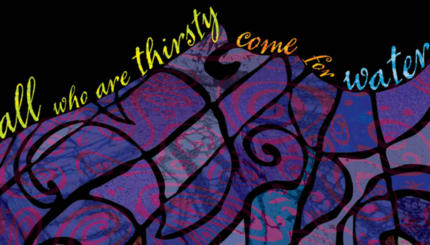Artist Siona Benjamin teaching art in the Sukkah
Celebrating Sukkot on the Canadian shores of Lake Ontario, as I did as a child, was fraught with complications. Evening temperatures often necessitated hats and heaters and our hot soup cooled before it had a chance to warm our insides. But the thrill of the holiday, the opportunity to sit out on nights it did not rain, under the green and the stars made it worthwhile. We lived in a middle-sized city with a small Jewish population but on our block there were two other families who sat in Sukkot. Our differing approaches to religion meant that we rarely shared meals but sitting out in the back yard we could hear each other repeat the same blessings and sing the same tunes and with that, our community felt expansive, our medley of practice seamless, and being Jewish was perfect.
That expansive safe inclusive feeling is essential to Sukkot. The holiday, which follows the hopefulness of Rosh Hashanah and the solemnity Yom Kippur, has us sitting in huts for seven days of ‘our joy,’ as our tradition calls this holiday. Sitting in Sukkot is supposed to remind us of the journey of the Israelites from Egypt to the Promised Land. Though the people of Israel complained pretty much non-stop during the trek, it was in many ways a pretty wonderful time. Despite living in temporary dwellings, throughout, they were guided by God’s presence; they were provided with ample food and drink in a dry, sparse dessert landscape. Outsiders attacked them but God assured their safety. And those who wandered in the wilderness knew God through miracles and revelation. Temporary and rough though it might have been, in many ways it was a time of joy and possibility like no other. Jews of many tribes lived together in peace, they had deep sense of the holy in their midst and their basic needs were more than adequately take care of. Being Jewish was perfect.
As the celebration of Sukkot nears, I’ve been thinking about what it takes to make a perfect Jewish space—even if only a temporary one. For my daughter that place has been summer camp. For my son, it is his school fall retreat. I’ve been blessed over the years to have many temporary Jewish spaces that capture the expansive, inclusive, joyful feeling that Sukkot is meant to inspire but one that has gained particular meaning for me in the last few years is the Be’chol Lashon Family Camp.
Every fall, Be’chol Lashon organizes a weekend of Jewish learning, living and sharing in the rolling hills just north of San Francisco. Like the Sukkot singing of my childhood, the diversity of this community helps me experience the Jewish world as inclusive and accepting. There are people of all ages, races, sexual orientations, family configurations. Some people come alone, others come with several generations in tow. There are many different kinds of religious Jews and secular Jews too. The scholars-in-residence have ranged over the years from Indian-American artist Siona Benjamin, to chef and Afro-culinary historian Michael Twitty, to this year’s Rabbi Gershom Sizomu from Uganda. This range embodies my belief that there are many ways to be a Jewish leader and help me to see the full vibrancy of modern Jewish life. Black, Asian, Latino and white Jews share meals having serious conversations about race as well as fun and silly discussions about pop culture. It is a safe space and one in which Jewish life is inclusive, expansive and vibrant. And though it is temporary, like Sukkot, the retreat gives me hope and inspires me for the complexities of daily Jewish life.
Literally and figuratively Sukkot are essential for Jewish life. We all need oases where we feel the pure joy of being Jewish in an accepting, inclusive safe environment. Just as the holiday of Sukkot gives us hope during the somber High Holy days, having a Jewish space that lives up to your vision of Jewish community—even if temporary—can fuel the fullness of Jewish life at other times. Creating or finding that space, can be as challenging as wandering in the dessert or sitting in a Sukkah with a space heater, but making the effort is definitely worth your while.
Sukkot
Pronounced: sue-KOTE, or SOOH-kuss (oo as in book), Origin: Hebrew, a harvest festival in which Jews eat inside temporary huts, falls in the Jewish month of Tishrei, which usually coincides with September or October.



